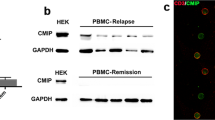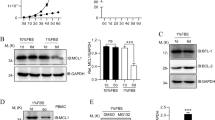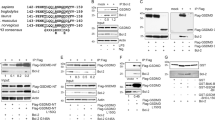Abstract
Gads is a SH2 and SH3 domain-containing, hematopoietic-specific adaptor protein that functions in signalling from the T cell receptor. Gads acts by linking SLP-76, bound by the carboxy-terminal Gads SH3 domain, to tyrosine phosphorylated LAT which contains binding sites for the Gads SH2 domain. Gads is distinguished from Grb2 and the closely related Grap protein by the presence of a 120 amino acid unique region between the SH2 domain and the carboxy terminal SH3 domain. Here we demonstrate that the unique region of Gads contains a capase cleavage site. Induction of apoptosis in lymphocytes results in detectable Gads cleavage by 60 min. Gads cleavage is blocked in vivo by treating cells with a caspase 3 inhibitor. A putative caspase 3 cleavage site was identified within the unique region and mutation of this site prevented Gads cleavage in vitro, and in vivo. The Gads cleavage products retained the predicted binding specificity for SLP-76 and LAT. Expression of the Gads cleavage products in Jurkat T cells inhibited NFAT activation following TCR cross linking. These findings indicate that cleavage of Gads in vivo could function to alter signalling downstream of the T cell receptor by disrupting cross talk between SLP-76 and LAT.
This is a preview of subscription content, access via your institution
Access options
Subscribe to this journal
Receive 50 print issues and online access
$259.00 per year
only $5.18 per issue
Buy this article
- Purchase on Springer Link
- Instant access to full article PDF
Prices may be subject to local taxes which are calculated during checkout






Similar content being viewed by others
References
Asada H, Ishii N, Sasaki Y, Endo K, Kasai H, Tanaka N, Takeshita T, Tsuchiya S, Konno T and Sugamura K. . 1999 J. Exp. Med. 189: 1383–1390.
Brunner T, Mogil RJ, LaFace D, Yoo NJ, Mahboubi A, Echeverri F, Martin SJ, Force WR, Lynch DH and Ware CF. . 1995 Nature 373: 441–444.
Buday L, Egan SE, Rodriguez Viciana P, Cantrell DA and Downward J. . 1994 J. Biol. Chem. 269: 9019–9023.
Bustelo XR, Ledbetter JA and Barbacid M. . (1992) Nature 356: 68–71.
Chan AC, Dalton M, Johnson R, Kong GH, Wang T, Thoma R and Kurosaki T. . 1995 EMBO. J. 14: 2499–2508.
Chan AC and Shaw AS. . 1996 Curr. Opin. Immunol. 8: 394–401.
Chen Y-R, Meyer CF, Ahmed B, Yao Z and Tan T-H. . 1999 Oncogene 18: 7370–7377.
Earnshaw WC, Martins LM and Kaufmann SH. . 1999 Annu. Rev. Biochem. 68: 383–424.
Fadeel B, Orrenius S and Zhivotovsky B. . 2000 Leukemia 14: 1514–1525.
Fang N, Motto DG, Ross SE and Koretzky GA. . 1996 J. Immunol. 157: 3769–3773.
Finco TS, Kadlecek T, Zhang W, Samelson LE and Weiss A. . 1998 Immunity 9: 617–626.
Hofmann TG, Hehner SP, Droge W and Schmitz ML . 2000 Oncogene 19: 1153–1163.
Hueber AO, Zornig M, Bernard AM, Chautan M and Evan G. . 2000 J. Biol. Chem. 275: 10453–10462.
Ishiai M, Kurosaki M, Inabe K, Chan AC, Sugamura K and Kurosaki T. . 2000 J. Exp. Med. 192: 847–856.
Jackman JK, Motto DG, Sun QM, Tanemoto M, Turck CW, Pelz GA, Koretzky GA and Findell PR. . 1995 J. Biol. Chem. 270: 7029–7032.
Ju ST, Panka DJ, Cui H, Ettinger R, el-Khatib M, Sherr DH, Stanger BZ and Marshak-Rothstein A. . 1995 Nature 373: 444–448.
Law CL, Ewings MK, Chaudhary PM, Solow SA, Yun TJ, Marshall AJ, Hood L and Clark EA. . 1999 J. Exp. Med. 189: 1243–1253.
Liu SK, Fang N, Koretzky GA and McGlade CJ. . 1999 Curr. Biol. 9: 67–75.
Liu SK and McGlade CJ. . 1998 Oncogene 17: 3073–3082.
Martin DA Siegel RM, Zheng L and Lenardo MJ. . 1998 J. Biol. Chem. 273: 4345–4349.
Motto DG, Ross SE, Wu J, Hendricks Taylor LR and Koretzky GA. . 1996 J. Exp. Med. 183: 1937–1943.
Muzio M, Stockwell BR, Stennicke HR, Salvesen GS and Dixit VM. . 1998 J. Biol. Chem. 273: 2926–2930.
Nel AE, Gupta S, Lee L, Ledbetter JA and Kanner SB. . 1995 J. Biol. Chem. 270: 18428–18436.
Nicholson DW, Ali A, Thornberry NA, Vaillancourt JP, Ding CK, Gallant M, Gareau Y, Griffin PR, Labelle M and Lazebnik YA. . 1995 Nature 376: 37–43.
Russell JH. . 1995 Curr. Opin. Immunol. 7: 382–388.
Villa P, Kaufmann SH and Earnshaw WC. . 1997 Trends Biochem. Sci. 22: 388–393.
Wange RL, Malek SN, Desiderio S and Samelson LE. . 1993 J. Biol. Chem. 268: 19797–19801.
Wange RL and Samelson LE. . 1996 Immunity 5: 197–205.
Weber JR, Orstavik S, Torgersen KM, Danbolt NC, Berg SF, Ryan JC, Tasken K, Imboden JB and Vaage JT. . 1998 J. Exp. Med. 187: 1157–1161.
Weiss A, Koretzky G, Schatzman RC and Kadlecek T. . 1991 Proc. Natl. Acad. Sci. USA 88: 5484–5488.
Yablonski D, Kuhne MR, Kadlecek T and Weiss A. . 1998 Science. 281: 413–416.
Yang X, Chang HY and Baltimore D. . 1998 Mol. Cell. 1: 319–325.
Yeh WC, Pompa JL, McCurrach ME, Shu HB, Elia AJ, Shahinian A, Ng M, Wakeham A, Khoo W, Mitchell K, El-Deiry WS, Lowe SW, Goeddel DV and Mak TW. . 1998 Science 279: 1954–1958.
Yuan J, Shaham S, Ledoux S, Ellis HM and Horvitz HR. . 1993 Science 75: 641–652.
Zhang J, Cado D, Chen A, Kabra NH and Winoto A (1998a). . Nature 392: 296–300.
Zhang W, Sloan-Lancaster J, Kitchen J, Tible RP and Samelson LE. . 1998b Cell 92: 83–92.
Zhang W, Sommers CL, Burshtyn DN, Stebbins CC, DeJarnette JB, Trible RP, Grinberg A, Tsay HC, Jacobs HM, Kessler CM, Long EO, Love PE and Samelson LE. . 1999 Immunity 10: 323–332.
Zhang W, Trible RP, Zhu M, Liu SK, McGlade CJ and Samelson LE. . 2000 J. Biol. Chem. 275: 23355–23361.
Zornig M, Hueber AO and Evan G. . 1998 Curr. Biol. 8: 467–470.
Acknowledgements
The authors thank Dr Stan Liu for lively discussions, Dr Gary Koretzky for anti-SLP-76 and anti-SLAP-130 antiserum and Dr Ian Clarke for isolating primary lymphocytes. This work was funded by operating grants from the Cancer Research Society and from the Medical Research Council of Canada to CJ McGlade. SJ Benn is supported by a Natural Science and Engineering Research Council Fellowship. CJ McGlade is a Research Scientist of the National Cancer Institute of Canada supported with funds from the Canadian Cancer Society.
Author information
Authors and Affiliations
Rights and permissions
About this article
Cite this article
Berry, D., Benn, S., Cheng, A. et al. Caspase-dependent cleavage of the hematopoietic specific adaptor protein Gads alters signalling from the T cell receptor. Oncogene 20, 1203–1211 (2001). https://doi.org/10.1038/sj.onc.1204218
Received:
Revised:
Accepted:
Published:
Issue Date:
DOI: https://doi.org/10.1038/sj.onc.1204218
Keywords
This article is cited by
-
Many cuts to ruin: a comprehensive update of caspase substrates
Cell Death & Differentiation (2003)
-
Cloning and characterization of human Src-like adaptor protein 2 and a novel splice isoform, SLAP-2-v
Oncogene (2003)
-
The role of Gads in hematopoietic cell signalling
Oncogene (2001)



